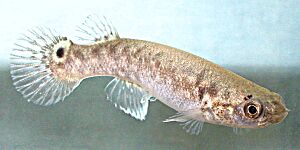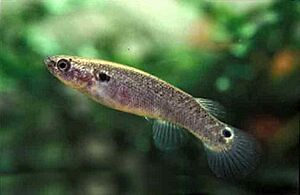Mangrove rivulus facts for kids
Quick facts for kids Mangrove rivulus |
|
|---|---|
 |
|
| Conservation status | |
| Scientific classification | |
| Synonyms | |
|
The mangrove rivulus or mangrove killifish (Kryptolebias marmoratus) is a special type of killifish. It belongs to the family called Rivulidae. This amazing fish lives in brackish (slightly salty) and marine (ocean) waters. You can find it along the coasts of Florida, through the Antilles islands, and along the eastern and northern Atlantic coasts of Mexico, Central America, and South America (down to Brazil).
This fish can handle many different conditions! It can live in very salty water or almost fresh water. It can also survive in temperatures from cool (12°C or 54°F) to quite warm (38°C or 100°F). What's even cooler is that it can live out of water for about two months! Most of these fish reproduce by themselves, which is called self-fertilization. They often live in areas with red mangrove trees and sometimes even hide in the burrows of Cardisoma guanhumi crabs.
Mangrove rivulus fish are usually small, about 1 to 3.8 cm (0.4 to 1.5 inches) long. Some can grow up to 7.5 cm (3 inches). Overall, this fish is common and not in danger. However, in the United States, it is considered a Species of Concern by the National Marine Fisheries Service.
Contents
Life on Land: How the Mangrove Rivulus Survives
The mangrove rivulus is an expert at living both in and out of water. It can spend up to 66 days in a row out of the water! When it's on land, it usually hides inside fallen logs. It breathes air through its skin during this time.
Hiding Spots and Body Changes
When out of water, the fish often goes into burrows made by insects inside trees. Here, it becomes less aggressive and territorial. Its gills change to help it keep water and nutrients. The fish also gets rid of nitrogen waste through its skin. When it goes back into the water, its gills change back to normal.
Jumping on Land
When the mangrove rivulus needs to move on land, it does a special "tail flip." It flips its head over its body towards its tail. This jumping technique helps the fish direct its jumps and make strong leaps. Scientists even released a video in 2013 showing this cool jumping method!
Reproduction: How Mangrove Rivulus Fish Have Babies
Scientists have not yet seen mangrove rivulus fish lay eggs in the wild. But studies in captivity show that they lay their eggs in shallow water. Sometimes, the eggs are even laid in places that become dry land during low tide.

Eggs and Hatching
The eggs can keep developing even when they are out of water. But once they are ready to hatch, they wait. They will only hatch when they are back in the water.
Self-Fertilization and Males
Most mangrove rivulus fish are hermaphrodites. This means they have both male and female reproductive parts. They can reproduce by self-fertilization, which means they can have babies all by themselves without another fish. However, some males do exist. There is strong genetic proof that sometimes a male will mate with a hermaphrodite. This is called outcrossing.
The number of males compared to hermaphrodites can change. For example, if there are more parasites in an area, the number of males might go up. In Florida, almost all mangrove rivulus fish are clones, meaning they are genetically identical. But in South and Central American pools, males usually make up 3 to 8% of the population. In some offshore islands in Belize, 20 to 25% of the fish are males.
K. marmoratus produces eggs through a process called meiosis. This process allows them to reproduce by self-fertilization. This way of reproducing can create groups of fish that are almost exactly alike genetically. This ability to self-fertilize has likely been around for hundreds of thousands of years. Self-fertilization helps make sure that reproduction happens, even if there are no other fish around.
Conservation: Protecting the Mangrove Rivulus
Overall, the mangrove rivulus is found in many places and is not considered endangered. The IUCN (International Union for Conservation of Nature) lists it as a species of Least Concern. In the United States, however, the National Marine Fisheries Service considers it a Species of Concern.
This fish was once thought to be rare in Florida. But surveys have shown that it is actually common in some areas of Florida, especially in the Florida Keys. The American Fisheries Society considers it vulnerable.
Scientists believe the mangrove rivulus could be a useful bioindicator species for estuary habitats. This means studying these fish could help us understand the health of these important coastal areas.
See also
- Amphibious fish
- Androdioecy
- Climbing gourami
- Mudskipper
- Walking catfish
- Walking fish


